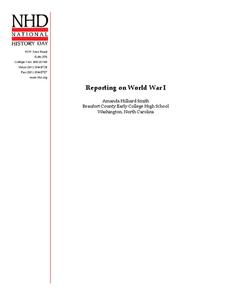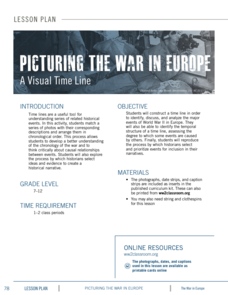National Endowment for the Humanities
How to Win a World War
High schoolers are have begun to learn the art of diplomacy with each other, but do they understand how diplomacy works at a global level? The second in a series of four lessons, guides scholars in evaluating primary sources. The why...
Curated OER
Learning From World War II and Connecting It to the Present
Compare and contrast World War II to the modern Iraq war with this instructional activity. After watching a film, learners use supporting evidence to support their point of view of the conflicts. Using the internet, they create a...
Curated OER
World War II - Memory Book
Eighth graders read about and reflect upon a variety of events that occurred during World War II. They conduct research on the Holocaust and Anne Frank's life, the attack on Pearl Harbor, American life during this time and the bombing of...
National History Day
“Saving the Bear”: The Russian Expeditionary Force of World War One
How have Russian politics affected countries on a global stage? The discussion of the Russian Revolution and World War I begins with an analysis of primary resource letters. Learners finish with a project where they create a timeline of...
National History Day
Reporting on World War I
Throughout history, newspapers have reported the events of the day as they unfolded. Using primary and secondary sources from World War I, scholars uncover how the American people learned of the events of the War to End All Wars. History...
US National Archives
The Home Front: How Did People Prepare for the War at Home?
Wars have a profound effect not only on a country's soldiers, but also on the everyday lives of its citizens. Invite young historians to discover how Britain prepared for the second World War by analyzing a series of government posters...
Smithsonian Institution
Women's Role in the War Effort
Did you know that many women were Confederate spies during the Civil War? The resource focuses particularly on the important role women played for both the Union and Confederacy. It uses exercises such as a discussion, video, analyzing...
Curated OER
United States Entry into World War I: A Documentary Chronology of World War I
Eleventh graders reconsider the events leading to U.S. entry into World War I through the lens of archival documents.
Curated OER
Lesson 3: Japan's "Southern Advance" and the March toward War, 1940-1941
High school historians interpret historical evidence presented in primary resources to decide if the southern advance was a reckless step toward war, or if it was reasonable. They research the Japanese southern advance tactics during the...
Curated OER
World War II: Modern History of Hawaii
Learners examine world geography by viewing a documentary film in class. In this World War II lesson, students discuss the role Hawaii played in the great battle and what type conflicts happened among the island chain. Learners view a...
National WWII Museum
Picturing the War in Europe: A Visual Time Line
Where does it fit in history? Learners consider the choices historians make when evaluating events by constructing a timeline of World War II. Using photographs of events in the conflict, they create a chronology. Once finished,...
Curated OER
To War Or Not To War?
Seventh graders research the political, societal, and economic factors of World War I, World War II, and the 2001 war against terrorism. They participate in class discussions, write journal entries, and conduct Internet research. ...
Facing History and Ourselves
Life for German Youth in the 1930s: Education, Propaganda, Conformity, and Obedience
The German youth faced an onslaught of propaganda when they went to school, thanks to the Nazi regime led by Hitler during World War II. Pupils relate their education experiences to German youth by analyzing primary source readings,...
Curated OER
Italian Enemy Aliens During World War II: Evacuation from Prohibited Zones
Students read and discuss the Enemy Alien Evacuation Order. They perform research by reading newspaper articles from February 1942 as well as investigating available information on the Internet. Students work in groups to create a...
British Council
Letters Home
When you're writing historical fiction, the past really can become the present — especially if you're writing in the present continuous tense! Cover World War I, verb tenses, censorship, and letter writing with one informative lesson and...
Facing History and Ourselves
A Scene from a Middle School Classroom
Citizens in the modern world can't imagine making the same social choices made by many Germans in the 1920s and 1930s, but they don't realize that they actually do it every day by ostracizing others. A case study of middle schoolers...
University of California
Decolonization
The ripple effect from one small event can impact many others. Young historians research the ripple effect World War II had on decolonization in the second installment of an eight-part series. Through primary and secondary documents as...
Curated OER
Cold War Roots and Events
Ninth graders examine the causes and major events of the Cold War. They listen to a lecture and fill in the blanks on a handout, and in two groups develop a proposal to deal with the Cuban Missile Crisis.
National Endowment for the Humanities
The Strategy of Containment, 1947–1948
How do people stop the spread of an ideology they don't think is right? Scholars research the policy of containment during the start of the Cold War. Small groups analyze primary sources to determine how the United States combated...
National WWII Museum
On Leave in Paris: Maps as Primary Sources
Primary sources—even those that seem mundane—offer a window into those who experienced history. Using a Red Cross map offered to soldiers stationed in Paris after World War II alongside worksheet questions, scholars consider what life...
Curated OER
Maus Lesson Plan
The artistic choices Art Spiegelman made in his graphic novel, Maus, are the focus of an exercise that asks class members to compare classic comic book forms with Spiegelman’s panels and frames. Directed to specific pages and guided by a...
Curated OER
The failure of Diplomacy, September-December 1941
High schoolers investigate four main issues of concern between US and Japan prior to US involvement in World War II. In this role play lesson, students will take the role of US and Japanese negotiators trying to find a diplomatic...
Curated OER
Lines From Behind the Lines
Fifth graders create a timeline of events in a soldiers life. In this World War I lesson, 5th graders learn about the Great Depression and World War I. Students watch video segments about World War I and examine primary sources from...
Curated OER
Gaining Insight into the WWII Era Through Electronic Records and the National Archives
Students are introduced to the variety of resources that are available to them online with regards to national archives and enlistment records. Individually, they use the database to find someone they know who enlisted before or during...

























